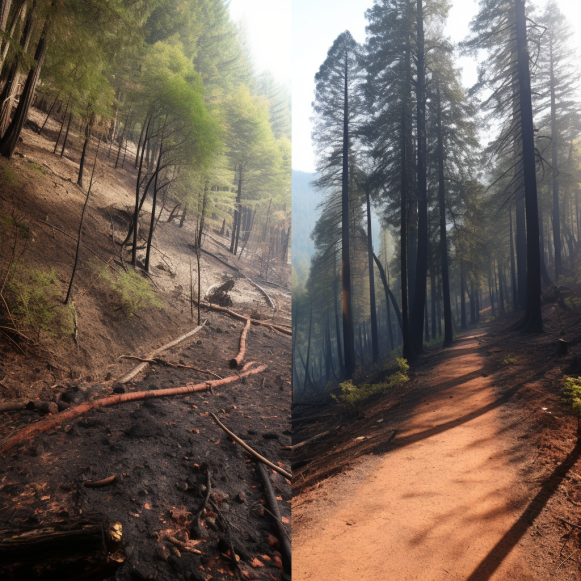Big Basin: Redwood trees’ recovery is ‘remarkable’ three years after huge fire, while some species are still struggling

90% of redwoods are resprouting, some birds are back, but salmon streams saw major erosion
More than three years after a wildfire devastated Big Basin Redwoods State Park in the Santa Cruz Mountains, the massive redwood trees in California’s oldest state park are regrowing at an astounding rate.
However, some wildlife species, particularly salmon and steelhead trout in the park’s streams, as well as some bird species, are still struggling and may take many years to recover.
Researchers who spoke at a recent scientific symposium on how Big Basin is faring in the aftermath of the 2020 CZU Lightning Complex Fire came to this conclusion.
The best news is that the park’s famed old-growth redwoods, some of which tower more than 250 feet and date back more than 1,500 years, are nearly all green again, with significant amounts of new growth showing after the wildfire’s flames charred their bark black and gave them a doomed appearance for a while.
“Coast redwoods are just supremely fire adapted, and they were well-prepared for this fire event, and they seem to be recovering, at least so far,” said Drew Peltier, an assistant professor of biology at the University of Nevada Las Vegas who has studied Big Basin’s post-fire recovery.
Peltier explained how, eight months after the fire, he and other Northern Arizona University researchers set up a camera high in a redwood tree about a mile from park headquarters to automatically take photos every day at the symposium, hosted Nov. 15 by the nonprofit Santa Cruz Mountains Bioregional Council.
The first image he displayed was from April 2021, and it showed a forest dominated by brown, burned redwoods. The following photo, taken in June, showed the same forest covered in green, the trees having regrown thickly in only two years.
“What we witnessed was quite remarkable.” “All of these trees are brown with no green foliage,” Peltier said of the first image. “And they’re fully leafed out two years later.” I almost didn’t recognize the image I pulled from today. The trees have become extremely bushy.”
On August 16, 2020, lightning strikes sparked the fire. It burned 86,509 acres in rural Santa Cruz and San Mateo counties, nearly three times the size of San Francisco. The Santa Cruz Mountains’ most destructive fire in recorded history destroyed 1,490 structures, mostly in and around Boulder Creek. One person was killed.
The fire consumed 97% of the 18,000 acres in Big Basin. It destroyed campgrounds, many of which were loved by generations of families, including the 1 million visitors per year.
“Ecologically, the park is doing just fine,” said Jon Keeley, a senior scientist at the US Geological Survey and a biology professor at UCLA who attended the symposium. “The forest is returning to its natural state.” “Approximately 90% of redwood trees are resprouting.”
Big Basin’s forests, according to Keeley, are recovering faster than the buildings and other visitor amenities.
State park officials reopened the park, albeit in a limited capacity. Because parking is limited, visitors are advised to make day-use reservations. There will be no camping. However, 4 miles of hiking trails and 18 miles of fire roads have reopened for mountain biking and hiking. A welcome center at Rancho Del Oso, on the park’s southern edge near Highway 1 and the Pacific Ocean, reopened earlier this month.
State park officials have held public meetings and focus groups to develop rebuilding plans. Their vision includes relocating some of the park’s buildings, camping, and parking away from the most vulnerable old-growth redwoods in the former headquarters area and relocating them elsewhere in the park, including at Little Basin, a property on the park’s eastern flank. A shuttle bus system is also being developed for visitors during peak times to help reduce traffic.
Will Fourt, a senior state parks planner, told the symposium that state parks officials are working on a more detailed “facilities management plan” with specifics about new campgrounds, utilities, parking, and buildings, which will be released to the public next year. Construction will take several years, he said, adding that the goal is to rebuild roughly the same number of campsites that existed prior to the fire.
“The vision includes rebuilding some things differently than they were in the past,” Fourt told the crowd, “while honoring the history of the park and striving to create future trails and camping experiences in the park that were most important to visitors.”
The park’s streams and fish are still a source of concern.
Jerry Smith, an emeritus professor at San Jose State University who has studied the park’s fish for 30 years, said that big storms this winter and the previous winter washed mud, rocks, and other debris down from bare slopes along the park’s western edges, filling parts of Waddell Creek. Logjams in the creek and its tributaries were caused by dead trees, including Douglas firs.
The changes are likely to have obstructed the passage of endangered steelhead trout and coho salmon, as well as filled in many of the pools on which the fish rely. He described a log jam the size of a football field in one section of Waddell Creek.
As a result, coho and steelhead have been nearly extinct in Waddell Creek over the last two years, he claims. It took the fish 15 to 20 years to recover after a similar disruption caused by massive storms in the winter of 1982-83, he said.
Another wet winter this year will continue the destructive trend until more vegetation grows on the park’s steep western slopes.
“Waddell got really hammered and is going to continue to get hammered,” Smith went on to say.
The recovery of the park’s bird species has been mixed. According to biologist Alex Rinkert, three years after the fire, some species, such as woodpeckers, robins, juncos, and warblers, are back in healthy numbers, while others, such as jays and chickadees, have declined due to changes in habitat and possibly food sources.
A few species, such as the endangered marbled murrelet, which lives in the decimated Douglas fir trees, have declined significantly “and may take decades to recover,” according to Rinkert.





